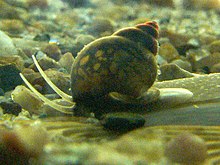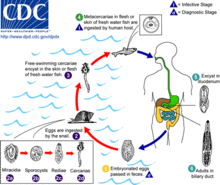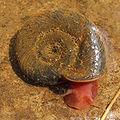Freshwater snail

Bithynia tentaculata, a small freshwater gastropod in the family Bithyniidae

Pomacea insularum, an apple snail

Planorbella trivolvis an air-breathing ramshorn snail
A
freshwater snail is one kind of freshwater mollusc, the other kind being freshwater clams and mussels, i.e. freshwater bivalves. Specifically a freshwater snail is a gastropod that lives in a watery non-marine (freshwater) habitat. The majority of freshwater gastropods have a shell,
with very few exceptions. Some groups of snails that live in freshwater
respire using gills. Others need to surface to breathe air.
According to present classification efforts, there are about 4,000 species of freshwater gastropods (3,795-3,972).
At least 33–38 independent lineages of gastropods have successfully colonized freshwater environments.It is not possible to quantify the exact number of these lineages yet, because they have yet to be clarified within the Cerithioidea.From six to eight of these independent lineages occur in North America.
Contents
- 1 Taxonomy
- 1.1 2005 taxonomy
- 1.2 2010 taxonomy
- 2 Neritimorpha
- 3 Caenogastropoda
- 4 Heterobranchia
- 5 As human food
- 6 Aquarium snails
- 7 Parasitology
- 8 See also
- 9 References
- 10 Further reading
|
Taxonomy
2005 taxonomy
The following cladogram is an overview of the main clades of gastropods based on the taxonomy of Bouchet & Rocroi (2005), with families that contain freshwater species marked in
boldface:(Some of the highlighted families consist entirely of freshwater
species, but some of them also contain, or even mainly consist of,
marine species.)
|
|
† Paleozoic molluscs of uncertain systematic position |
|
|
† Basal taxa that are certainly Gastropoda |
|
|
Patellogastropoda |
|
|
Vetigastropoda |
|
|
Cocculiniformia |
|
| Neritimorpha |
|
† Paleozoic Neritimorpha of uncertain systematic position |
|
|
† Cyrtoneritimorpha |
|
|
Cycloneritimorpha: Neritiliidae and Neritidae |
|
|
|
| Caenogastropoda |
|
Caenogastropoda of uncertain systematic position |
|
|
Architaenioglossa: Ampullariidae and Viviparidae |
|
|
Sorbeoconcha: Melanopsidae, Pachychilidae, Paludomidae, Pleuroceridae, Semisulcospiridae and Thiaridae |
|
| Hypsogastropoda |
|
Littorinimorpha: Littorinidae, Amnicolidae, Assimineidae, Bithyniidae, Cochliopidae, Helicostoidae, Hydrobiidae, Lithoglyphidae, Moitessieriidae, Pomatiopsidae and Stenothyridae |
|
|
Ptenoglossa |
|
|
Neogastropoda: Buccinidae and Marginellidae |
|
|
|
|
|
| Heterobranchia |
|
Lower Heterobranchia: Glacidorbidae and Valvatidae |
|
| Opisthobranchia |
|
Cephalaspidea |
|
|
Thecosomata |
|
|
Gymnosomata |
|
|
Aplysiomorpha |
|
|
Acochlidiacea: Acochlidiidae, Tantulidae and Strubelliidae |
|
|
Sacoglossa |
|
|
Cylindrobullida |
|
|
Umbraculida |
|
|
Nudipleura |
|
|
|
| Pulmonata |
|
Basommatophora: Chilinidae, Latiidae, Acroloxidae, Lymnaeidae. Planorbidae ► and Physidae - all these six families together form the clade Hygrophila |
|
|
Eupulmonata |
|
|
|
|
|
|
|
|
2010 taxonomy
The following cladogram is an overview of the main clades of gastropods based on the taxonomy of Bouchet & Rocroi (2005), modified after Jörger et al. (2010) and simplified with families that contain freshwater species marked in
boldface:(Marine gastropods (Siphonarioidea, Sacoglossa, Amphiboloidea,
Pyramidelloidea) are not depicted within Panpulmonata for
simplification. Some of these highlighted families consist entirely of
freshwater species, but some of them also contain, or even mainly
consist of, marine species.)
|
|
† Paleozoic molluscs of uncertain systematic position |
|
|
† Basal taxa that are certainly Gastropoda |
|
|
Patellogastropoda |
|
|
Vetigastropoda |
|
|
Cocculiniformia |
|
| Neritimorpha |
|
† Paleozoic Neritimorpha of uncertain systematic position |
|
|
† Cyrtoneritimorpha |
|
|
Cycloneritimorpha: Neritiliidae and Neritidae |
|
|
|
| Caenogastropoda |
|
Caenogastropoda of uncertain systematic position |
|
|
Architaenioglossa: Ampullariidae and Viviparidae |
|
|
Sorbeoconcha: Melanopsidae, Pachychilidae, Paludomidae, Pleuroceridae, Semisulcospiridae and Thiaridae |
|
| Hypsogastropoda |
|
Littorinimorpha: Littorinidae, Amnicolidae, Assimineidae, Bithyniidae, Cochliopidae, Helicostoidae, Hydrobiidae, Lithoglyphidae, Moitessieriidae, Pomatiopsidae and Stenothyridae |
|
|
Ptenoglossa |
|
|
Neogastropoda: Buccinidae and Marginellidae |
|
|
|
|
|
| Heterobranchia |
|
Lower Heterobranchia: Valvatidae |
|
| Euthyneura |
|
Nudipleura |
|
|
|
Euopisthobranchia |
|
| Panpulmonata |
|
Glacidorboidea with the only family Glacidorbidae |
|
|
|
Hygrophila: Chilinidae, Latiidae, Acroloxidae, Lymnaeidae. Planorbidae ► and Physidae |
|
|
|
Acochlidiacea: Acochlidiidae, Tantulidae and Strubelliidae |
|
|
Eupulmonata |
|
|
|
|
|
|
|
|
|
|
|
|
|
|
|
|
Neritimorpha
Primitive "Prosobranch" gilled snails with a shelly operculum.
- Neritiliidae, 5 extant freshwater species
- Neritidae, largely confined to the tropics, also the rivers of Europe, family includes the marine "nerites". There are about 110 extant freshwater species.
-
Family Neritidae, shells of Theodoxus fluviatilis.
-
Family Neritidae, Neritina natalensis
Caenogastropoda
A large group of gilled operculate snails, largely marine. In
freshwater habitats there are ten major families, as well as other
families of lesser importance:
- Architaenioglossa
- Ampullariidae, an exclusively freshwater family hat is largely tropical and includes the large "apple snails" kept in aquaria.105-170 species.
- Viviparidae,
medium to large snails, live-bearing, commonly referred to as "mystery
snails". World wide except South America, and everywhere confined to
fresh waters.125-150 species.
-
Family Ampullariidae, Pomacea bridgesii.
-
Family Viviparidae, Viviparus viviparus.
- Sorbeoconcha
- Melanopsidae, family native to rivers draining to the Mediterranean, also Middle East, and some South Pacific islands.About 25-50 species.
- Pachychilidae - 165-225 species. native to South and Central America. Formerly included with the Pleuroceridae by many authors.
- Paludomidae - about 100 species in south Asia, diverse in African Lakes, and Sri Lanka.Formerly classified with the Pleuroceridae by some authors.
- Pleuroceridae, abundant and diverse in eastern North America, largely high-spired snails of small to large size.About 150 species.
- Semisulcospiridae, - primarily eastern Asia, Japan, also the Juga snails of northwestern North America. Formerly included with the Pleuroceridae. About 50 species.
- Thiaridae, high-spired parthenogenic snails of the tropics, includes those referred to as "trumpet snails" in aquaria.About 110 species.
-
Family Pleuroceridae, Io fluvialis.
-
Family Semisulcospiridae, Semisulcospira kurodai.
-
Family Thiaridae, Melanoides tuberculata.
- Littorinimorpha
- Littorinidae - 2 species in the genus Cremnoconchus are freshwater living in waterfalls.Other species are marine
- Amnicolidae - about 200 species.
- Assimineidae - about 20 freshwater species,other are marine
- Bithyniidae, small snails, native to Eastern Hemisphere.About 130 species.
- Cochliopidae - 246 species.
- Helicostoidae, the only species Helicostoa sinensis lives in China.
- Hydrobiidae, small to very small snails found world wide.About 1250 freshwater species other are marine.

Clea helena, family Buccinidae.
- Lithoglyphidae - about 100 species.
- Moitessieriidae - 55 species.
- Pomatiopsidae, small amphibious snails scattered worldwide, most diverse in eastern and Southeast Asia. About 170 species.
- Stenothyridae - about 60 freshwater species,others are marine.
- Neogastropoda
- Buccinidae - 8-10 freshwater species in the genus Clea,native to Southeast Asia. Other Buccinidae are marine.
- Marginellidae - 2 freshwater species in the genus Rivomarginella, native to Southeast Asia. Other Marginellidae are marine.
Heterobranchia

Family Valvatidae, shells of
Valvata sibirica, scale is in mm


Acochlidium fijiiensis is one of very few freshwater gastropods without a shell.
- Lower Heterobranchia
- Glacidorbidae - 20 species.
- Valvatidae, small low-spired snails referred to as "valve snails". 71 species.
- Acochlidiacea
- Acochlidiidae (including synonym Strubelliidae) - 5 shell-less species: Acochlidium amboinense, Acochlidium bayerfehlmanni, Acochlidium fijiiensis, Palliohedyle sutteri and Strubellia paradoxa
- Tantulidae - there is only one species which is shell-less Tantulum elegans.
- Pulmonata, Basommatophora
Basommatophorans
are pulmonate or air-breathing aquatic snails, characterized by having
their eyes located at the base of their tentacles, rather than at the
tips, as in the true land snails Stylommatophora.
The majority of basommatophorans have shells that are thin,
translucent, and relatively colorless, and all five freshwater
basommatophoran families lack an operculum.
- Chilinidae, small to medium-sized snails confined to temperate and cold South America. About 15 species.
- Latiidae, small limpet-like snails confined to New Zealand. One or three species.
- Acroloxidae - about 40 species.
- Lymnaeidae, found worldwide, but are most numerous in temperate and northern regions.These are the dextral (right-handed) pond snails. About 100 species.
- Planorbidae, "rams horn" snails, with a worldwide distribution.About 250 species.
- Physidae, left-handed (sinistral) "pouch snails", native to Europe, Asia, North America. About 80 species.
-
Family Lymnaeidae, Lymnaea stagnalis.
-
Family Physidae, Physella acuta.
-
Family Planorbidae, Planorbarius corneus.
As human food
Several different freshwater snail species are eaten in Asian cuisine.
Archaeological investigations in Guatemala have revealed that the diet of the Maya of the Classic Period (AD 250-900) included freshwater snails.
-
A dish of cooked freshwater nerites from the Rajang River, Sarawak, Malaysia
-
A dish of cooked freshwater snails, ampullariids and viviparids from Poipet, Cambodia
Aquarium snails
In the developed world, people encounter freshwater snails most
commonly in aquaria along with tropical fish. Species available vary in
different parts of the world. In the United States, commonly available
species include ramshorn snails such as
Planorbella duryi, apple snails such as
Pomacea bridgesii, the high-spired thiarid malaysian trumpet snail
Melanoides tuberculata, and several
neritina species.
Parasitology

Life cycle of two liver fluk species which have freshwater snails as intermediate hosts
Freshwater snails are widely known to be hosts in the lifecycles of a variety of human and animal parasites, particularly trematodes or "flukes". Some of these relations for prosobranch snails include
Oncomelania in the family Pomatiopsidae as hosts of
Schistosoma, and
Bithynia,
Parafossarulus and
Amnicola as hosts of
Opisthorchis.
Thiara and
Semisulcospira may host
Paragonimus, and
Goniobasis (older term including
Elimia,
Juga and other small high-spired pleurocerid snails) may host
Nanophyetus salmincola.Basommatophoran snails are even more widely infected, with many
Biomphalaria (Planorbidae) serving as hosts for
Schistosoma mansoni,
Fasciolopsis and other parasitic groups.The tiny
Bulinus snails are hosts for
Schistosoma haematobium. Lymnaeid snails (Lymnaeidae) serve as hosts for
Fasciola and the cerceriae causing swimmer's itch.



 Family Neritidae, shells of Theodoxus fluviatilis.
Family Neritidae, shells of Theodoxus fluviatilis. Family Neritidae, Neritina natalensis
Family Neritidae, Neritina natalensis Family Ampullariidae, Pomacea bridgesii.
Family Ampullariidae, Pomacea bridgesii. Family Pleuroceridae, Io fluvialis.
Family Pleuroceridae, Io fluvialis. Family Semisulcospiridae, Semisulcospira kurodai.
Family Semisulcospiridae, Semisulcospira kurodai. Family Thiaridae, Melanoides tuberculata.
Family Thiaridae, Melanoides tuberculata.

 Family Lymnaeidae, Lymnaea stagnalis.
Family Lymnaeidae, Lymnaea stagnalis. Family Planorbidae, Planorbarius corneus.
Family Planorbidae, Planorbarius corneus. A dish of cooked freshwater nerites from the Rajang River, Sarawak, Malaysia
A dish of cooked freshwater nerites from the Rajang River, Sarawak, Malaysia




No comments:
Post a Comment